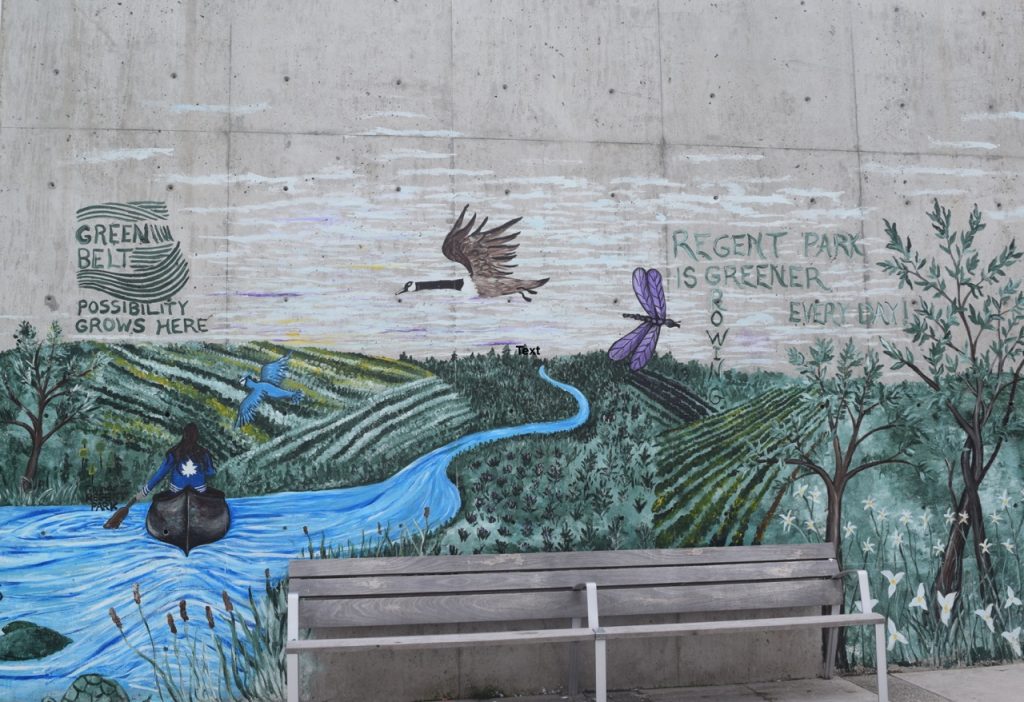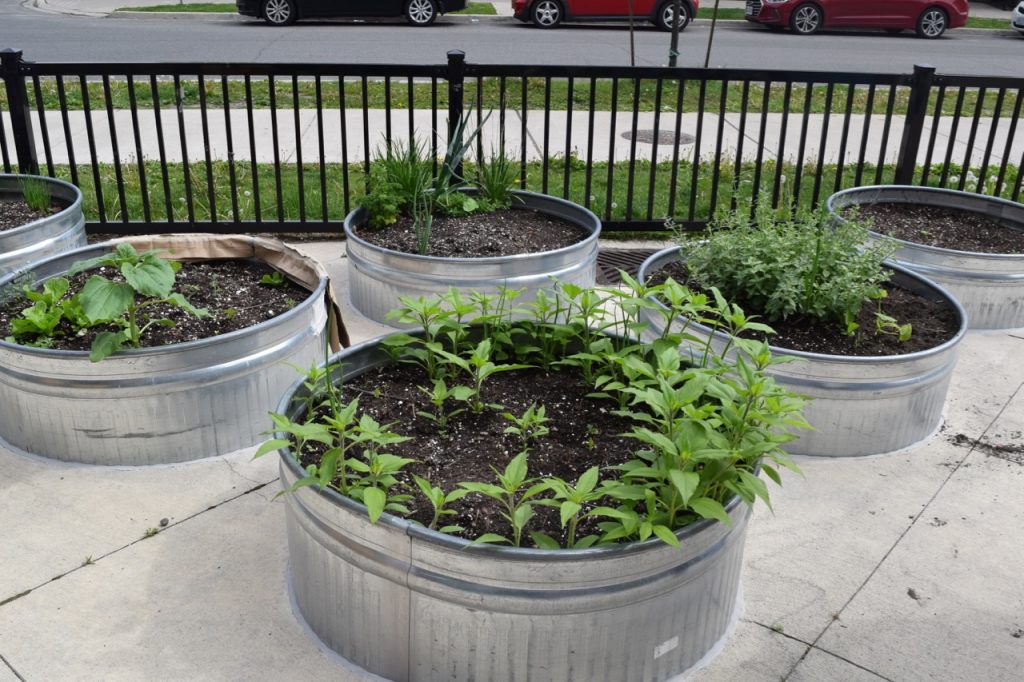
Regent Park Mural at CRC. Photograph by Author.
Throughout all wards of Toronto, one can find people growing food. There are more than 200 documented urban agriculture spaces including allotment gardens in Parks, Forestry & Recreation land; collectively-managed garden spaces on land owned by other city and provincial agencies, non-profits, and private landlords; community gardens in social housing; school gardens; rooftop gardens; household gardens; and larger-scale commercial urban farms, among others.
Colleen Hammelman
Assistant Professor, Department of Geography and Earth Sciences, University of North Carolina at Charlotte, https://clas-pages.uncc.edu/colleen-hammelman/
2016-2017 Culinaria Research Centre Postdoctoral Fellow
This blog relies on a series of in-depth interviews with key stakeholders during 2016-2017 to tell some of the story of the bustling Toronto urban agriculture movement.
People have engaged in urban agriculture projects throughout the history of the city for a variety of reasons. Some seek to supplement food budgets, put their hands in the soil, reduce food miles, get exercise and spend time outdoors, and increase access to foods grown organically. While others focus on less tangible benefits including feelings of improved mental health, connecting to cultural traditions, and reducing social isolation, particularly for newcomers. One stakeholder interviewed discussed how multiculturalism can flourish in these gardens:
So, I think there’s a lot of opportunities in urban agriculture and for a lot of people it’s interesting because it’s also becoming very multicultural in terms of what is grown on these lands. So, I remember in one of the gardens they try to grow produce from other countries and then folks are like, “Well, what is it?” “I don’t know how to harvest it because I don’t know what it is.” But then that learning opportunity is there as well so I think to have ethnic crops being grown, there seems to be a lot of interest in growing that…I think urban agriculture, in all its dimensions, has played a large role in bringing new food to Toronto. A lot of the so-called world crops have come from not just online research stations, but from backyard growers, community gardeners, who have been growing that kind of food here for years.
However, finding land for these projects is increasingly a challenge in Toronto. The vast majority of growers in these spaces lease the land. There are years-long waitlists for many of the garden spaces in Toronto and every person interviewed for this research reported a key challenge as gaining access to land. For example, one stakeholder indicated that nearby residents volunteer in a rooftop garden as a way to overcome their limited land access.

Gardens surrounding a residential building in the old part of Regent Park. Photograph by Author.
This is the only space. For some people here, this is the only space where they’re able to access – feel like they have some sort of a private public space to grow. They didn’t get a community garden plot and you can’t just grow things randomly in the community parks. So, this is really just the only space where they connect with a garden.
In response to these challenges, the Toronto Food Policy Council (TFPC) formulatedGrowTO: An urban agriculture action plan for Toronto, which pushed for finding new avenues to free up city land for more agricultural uses. This includes a multi-year project to make it easier to establish market gardens in Hydro corridors. City Council also recently approved the keeping of backyard chickens in some parts of the city, a move hailed by many urban growers.
One neighbourhood in the city with a particularly vibrant history of growing food is Regent Park in the eastern side of downtown Toronto. Vibrant growing spaces have been located throughout the social housing complex since its design in the 1940s and 1950s. The plans, relying on Ebenezer Howard’s ideas of a ‘garden city’, sought to create a park-like setting that included opportunities for residents to plant gardens near their homes (Johnson and Johnson, 2017). In the past decades, Toronto Community Housing also worked with TFPC food animators to develop community gardens and community food projects in much of Toronto’s social housing (Roberts, 2010). As a result, more than 500 garden projects could be found in Regent Park in the early 2000s.

Raised bed and container gardens in front of the CRC Community Food Centre. Photograph by Author.
Regent Park is now undergoing a 15-20 year, one-billion dollar revitalization. The revitalization is also embracing demand for urban growing spaces, but in new ways that raise questions about the ability of residents to continue to access growing spaces as they have in the past. The collaborating developer, Daniel’s Corporation, recognized the need to incorporate growing spaces in the new development. Thus far, a 6-acre park space in the center of Regent Park includes a community oven, greenhouse, and garden plots. Garden spaces have also been incorporated into the rooftop of new, market-rate buildings. It includes a 20,000 square foot, manicured park (the SkyPark) on top of the OneCole Condominiums. In promotional materials for the DuEast building, Daniel’s Corporation points to the rooftop community garden plots as ‘trailblazing’ the work for incorporating urban agriculture into residential buildings (Daniels DuEast, 2018). TCH also indicates that it plans to include rooftop gardens and green roofs in its buildings, but construction remains underway.
Finally, several community gardening spaces can be found at the CRC’s Community Food Centre. The CFC built raised-bed plots in front of the building and a pop-up container gardening program throughout the neighborhood, manages allotment gardens throughout Regent Park, and is growing a Yes In My Backyard program which seeks to connect aspiring gardeners with nearby unutilized backyards.

CRC Garden Barrels. Photograph by Author.
Despite all of these opportunities, there remain concerns. As the revitalization continues, allotment gardens are closing while the CRC has years-long waitlists for its gardens. Additionally, there have been challenges in the building of new garden spaces that rely on raised beds and collective management by nonprofits, instead of individual use. Stakeholders interviewed for this research recognized that growing food in containers on roofs, with collective decision making as to what will be grown and how, is simply not the same has having a garden in the ground, outside your doorstep in which individuals can steward the land as they desire. As such, there remains much to be seen as to how the revitalization will impact the ability of newcomer growers in Regent Park to make their mark on the fabric of Toronto’s foodscape.
References:
Daniels DuEast (2018) Urban Living Reimagined: Urban Agriculture. Daniels Corporation. Web. http://danielsdueast.com/urban-agriculture/ Accessed April 4, 2018.
Johnson, L.C. and Johnson, R.E. (2017) Regent Park Redux: Reinventing Public Housing in Canada. New York: Routledge.
Roberts, W. (2010) Food policy encounters of a third kind: How the Toronto Food Policy Council socializes for sustain-ability. In A. Blay-Palmer, ed. Imagining Sustainable Food Systems: Theory and Practice. Taylor and Francis.